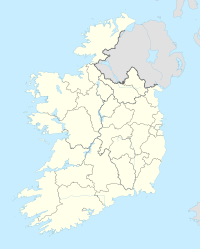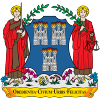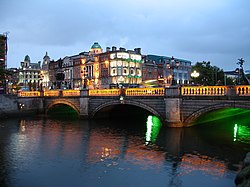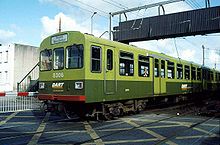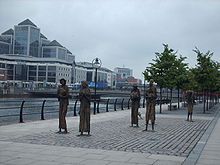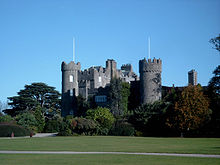Dublin
| Dublin Baile Átha Cliath Dublin |
||
|---|---|---|
|
|
||
| Coordinates | 53 ° 21 ′ N , 6 ° 16 ′ W | |
| Symbols | ||
|
||
|
Motto “Obedientia Civium Urbis Felicitas” The obedience of the citizens is the happiness of the city |
||
| Basic data | ||
| Country | Ireland | |
| Leinster | ||
| county | Dublin | |
| ISO 3166-2 | IE-L | |
| height | 20 m | |
| surface | 115 km² | |
| Residents | 553,165 (April 2016 census) | |
| density | 4,810.5 Ew. / km² | |
| Telephone code | +353/01 | |
| Website | www.dublin.ie (English) | |
| politics | ||
| mayor | Paul McAuliffe | |
|
The O'Connell Bridge over the Liffey at night
|
||
Dublin ([ ˈdʌblɪn ], locally also [ dʊbᵊlən ]; Irish Baile Átha Cliath ([ ˈbalʲɑːˈkʲlʲiə ] or [ ˈbʲlʲɑːˈkʲlʲiə ])) is the capital and largest city of the Republic of Ireland . The German translation is "Stadt an der Hürdenfurt". The English name comes from the Irish Duibhlinn ([ ˈdivʲ.lʲiːnʲ ]), "black pond".
geography
landscape
Dublin is located on the east coast of the island of Ireland , at the mouth of the River Liffey in Dublin Bay . Dublin is on average 20 meters above sea level.
The Liffey divides Dublin into the northern part ( Northside ) and the more elegant south ( Southside ), although this division is less sharp today than in previous decades. The inner city gets its structure from the cross from the River Liffey with its numerous bridges and the main axis O'Connell Street - Grafton Street - Harcourt Street. Most of the department stores are here, but also Trinity College with its famous library and St. Stephen's Green municipal park . The streets in typical Georgian style can be found mainly in the area around Merrion Square, near the National Gallery and at the seat of the state government ( Leinster House ), around St. Stephen's Green, but also on the north side at Mountjoy Square. This area is enclosed by North Circular Road and South Circular Road . Outside the city center are the residential quarters, some of which still have a very uniform style; the classic working-class Cabra district consists of long rows of tiny houses made of bricks, Marino is an example of a middle-class settlement designed on the drawing board, in Beaumont semi-detached , semi-detached houses predominate .
climate
Dublin has a maritime climate, characterized by mild winters, cool summers and few extreme temperatures. Contrary to popular belief, the amount of precipitation is barely half that of western Ireland. Dublin has on average the same number of rainy days as London . The average maximum daily temperature in January is 7.6 ° C and in July 18.9 ° C. The sunniest months are usually May and June with an average of 6 hours of sunshine per day. The rainiest month is on average August, the driest are March and April.
Dublin has a microclimate that makes the city a few degrees warmer than the surrounding area. There is also a small difference in temperature between the city center and the Dublin suburbs (which are a bit cooler), as well as the city center and Dublin Airport to the north of the city.
Due to the mild climate, the lowest temperature measured so far is -12 ° C, the highest 31 ° C. Snow is rather rare in winter.
| Dublin | ||||||||||||||||||||||||||||||||||||||||||||||||
|---|---|---|---|---|---|---|---|---|---|---|---|---|---|---|---|---|---|---|---|---|---|---|---|---|---|---|---|---|---|---|---|---|---|---|---|---|---|---|---|---|---|---|---|---|---|---|---|---|
| Climate diagram | ||||||||||||||||||||||||||||||||||||||||||||||||
| ||||||||||||||||||||||||||||||||||||||||||||||||
|
Average monthly temperatures and rainfall for Dublin
Source: wetterkontor.de
|
|||||||||||||||||||||||||||||||||||||||||||||||||||||||||||||||||||||||||||||||||||||||||||||||||||||||||||||||||||||||||||||||||||||||||||||||||||||||||||||||||||||||||||||||||||||||||||||||||||
history
The history of Dublin is closely linked to the history of Ireland in general .
The first known mention of Dublin is in the writings of Ptolemy from 140 under the name Eblana . Originally the city consisted of a Celtic settlement with the name "Áth Cliath", which means something like "Hurdle ford". In 842 Vikings also founded their own village, which they called “Duibhlinn”, roughly “black pond”, after a body of water they used as a harbor basin at the mouth of the River Poddle in the Liffey. The power of the Kingdom of Dublin they founded was lost after the Battle of Clontarf in 1014.
The city was conquered in 1170 by the Anglo-Normans under the leadership of Richard de Clare and his Irish ally Diarmuid Mac Murchadha Caomhánach . From 1172 Dublin became the administrative center of the Anglo-Normans. At the time, the city had extensive international trade links with Scandinavia, Iceland, Great Britain and, increasingly, France.
The area of jurisdiction of the city was laid down in a deed in 1192. In total, an area of six square miles was assigned by decree of King Henry II . In principle, the city remained self-governing within these boundaries.
In 1204 King John of England ordered the construction of a fortress in Dublin ( Dublin Castle ) to strengthen his position of power in the country. In the following centuries this castle became the British administrative center in Ireland. The British Viceroy lived in this castle until 1782.
In 1229 the free citizens and honorary citizens of the city were granted the right to elect a mayor every year. The city council consisted of 24 prominent citizens, mostly merchants.
The plague came to Dublin in 1348 and caused a considerable shrinkage of the (now predominantly English) population.
Dublin was the capital of the Kingdom of Ireland between 1541 and 1800 .
In the 17th century the city expanded rapidly, consolidating its position as the capital of Ireland as the seat of the Irish Parliament. After a rebellion of the United Irishmen in 1798, which aimed to establish Ireland as an independent republic, Ireland was united with the Kingdom of Great Britain to form the United Kingdom of Great Britain and Ireland in 1801 by the Act of Union and Dublin became the headquarters of the British administration in Ireland.
As great famine ( . English Great Famine , Irish potato famine or Irish An Gorta Mór ) in the story received famine from 1845 to 1849 (or 1851) was the result of several potato - crop failure - by the then main food of poor Population of Ireland was destroyed - but also of the social and political conditions. More and more rural residents fled to the capital in search of food. The famine had devastating effects on Ireland, killing an estimated one million Irish people and emigrating another million, primarily to Canada , Australia and the United States .
In 1916 there was an uprising against the British in Dublin ( Easter Rising ). In 1919 Irish MPs established the Irish Parliament Dáil Éireann and declared Ireland's independence. This was followed by the Irish War of Independence and then the Irish Civil War , which caused great damage in Dublin. Many of the most important buildings were destroyed.
In 1922, after the end of the Anglo-Irish War, the independence of 26 of Ireland's 32 counties was recognized by the former colonial power and Dublin became the capital of the Free State of Ireland . The status of the Free State was replaced in 1937 by the Irish Constitution (Bunreacht na hÉireann), which made "Ireland", or in Irish "Éire", the name of the state and the elected President of Ireland as head of state. In 1949 Ireland left the British Commonwealth and officially referred to itself as a republic .
Since Ireland joined the European Community in 1973, Dublin has developed into a European metropolis. This was accompanied by a displacement of parts of the residential population from the city center, accompanied by social and political tensions ( gentrification ).
In 1988 Dublin officially celebrated its 1000th anniversary.
name of the city
The name Dublin is the English form of Duibhlinn (Irish for "black pond", dubh , black, linn , pond) and was adopted by the Vikings for their own village. “Black” here means more of a deeper body of water that was suitable for creating a harbor. Its approximate location today is taken by the Dubh Linn Garden just south of Dublin Castle. The River Poddle, which flowed into the Liffey here, now runs underground.
The Irish name of the city is Baile Átha Cliath (Irish for "City of Hurdles Ford"), which refers to a settlement founded by King Mael Sechnaill II in 988 on the strategically important easternmost ford through the River Liffey. With cliath (hurdle, reed hurdle) is meant a wickerwork that was created to make it easier to cross the ford.
population
Around 530,000 people live within the city limits. About 1.2 million people live in the Dublin region (Réigiúin Átha Cliath), which also includes the suburbs and satellite cities as well as some more rural regions of the former County Dublin . Approximately 1.1 million live in the Greater Dublin Area (CSO Census 2011), this area includes the urban area including the suburbs in the counties of Fingal , South Dublin and Dún Laoghaire-Rathdown , but not the rural regions.
politics
City Councilor and Mayor
The Dublin City Council has been composed as follows since the local elections on May 24, 2019:
| Political party | Seats |
|---|---|
| Fianna Fáil | 11 |
| Green party | 10 |
| Fine Gael | 9 |
| Labor Party | 8th |
| Sinn Féin | 8th |
| Non-party, smaller groups | 17th |
The city council elects the Lord Mayor of Dublin annually. Hazel Chu (Green Party) was elected on June 29, 2020.
Institutions
The Irish government is based in Dublin. The official residence of the Irish President is Áras an Uachtaráin , a building that is located in Phoenix Park . The two chambers of the Oireachtas meet in the Leinster House.
Taoiseach is the title of the Irish Prime Minister . He is based in Dublin.
The Four Courts ( Four Courts , Irish : Na Ceithre Cúirteanna ) is the main courthouse Ireland. It houses the Supreme Court , the High Court and the Central Criminal Court of Ireland.
Dublin is the seat of a Catholic and an Anglican Archbishop.
Culturally, Dublin has developed very strongly in recent years due to the economic boom. In addition to the (with tourists) well-known quarter of Temple Bar with many nightclubs, new and trendy bars, nightclubs and restaurants have also established themselves in the rest of the city center (especially along the Liffey).
With the construction of the International Financial Services Center (IFCS) in 1987, international financial service providers have increasingly been attracted in recent years.
Town twinning
Dublin is twinned with
-
 San José , United States (since 1986)
San José , United States (since 1986) -
 Liverpool , United Kingdom (since 1997)
Liverpool , United Kingdom (since 1997) -
 Barcelona , Spain (since 1998)
Barcelona , Spain (since 1998) -
 Beijing , People's Republic of China (since 2011)
Beijing , People's Republic of China (since 2011) -
 La Paz , Bolivia (since 2012)
La Paz , Bolivia (since 2012)
economy
Dublin was historically the center of brewing (including Guinness ). Over time, Dublin developed into a center of the pharmaceutical industry (including Pfizer ) and the IT sector (including the European headquarters of Google , Microsoft , Facebook , PayPal , Zynga and Yahoo ). Most recently, at the end of September 2011, Twitter announced the establishment of its European headquarters. According to a study by PWC , Dublin was the second most attractive city for corporate headquarters in Europe after Antwerp in 2011 .
Furthermore, Dublin is the financial center of Ireland. Many European banks (including Citigroup, Commerzbank, WestLB, LBBW, Helaba) and insurance companies (including Irish Life, London Life) have branches there. In addition, the (most important) Irish stock exchange, the Irish Stock Exchange , and the Irish Enterprise Exchange are located in Dublin.
The four largest Irish airlines Aer Arann , Aer Lingus , CityJet and Ryanair have their headquarters in Dublin.
During the time of the " Celtic Tiger ", extensive and extensive revitalization of the city center also fell, above all the conversion of the old port area into office and residential space. The largest projects include the Dublin Docklands and Spencer Dock Docklands areas .
Tourism plays an important role in Dublin's economy. With almost five million foreign visitors, Dublin was the 25th most visited city in the world in 2016. Tourists brought in $ 1.9 billion in revenue that same year. Most of the foreign visitors came from Europe and the USA.
traffic
Ireland's entire transport system is geared towards Dublin.
- port
Ferry connections to Liverpool and Holyhead exist via the port of Dublin and, since 2014, also to Cherbourg .
- Rail transport
The two largest train stations are Heuston Station and Connolly Station . Heuston Station connects Dublin with cities in the west and south of the country, while Connolly Station has links to Belfast , Sligo and Wexford .
- Road network
Dublin is the hub of the Irish road network . The main national roads start in the city and lead to all parts of the country. The M50 motorway is the busiest road in Ireland. It leads in a semicircle west around the city. Part of the motorway, the so-called Westlink near Lucan , is subject to tolls. The construction of the M50 took almost 20 years and was completed in 2005. The motorway is currently being expanded from two to three lanes in each direction and the most important junctions are being expanded.
A bypass is also planned for the east of the city. The first part of the route, the Dublin Port Tunnel, opened in December 2006 after six years of construction. The city administration hopes to use him to move a large part of the truck traffic out of the city center. The second part of the project will then connect the port with the road network in the south of the city. However, there are no specific plans for this yet. Even the construction of the Dublin Port Tunnel has significantly exceeded the originally planned budget. The first plans were based on a single tunnel tube. It was mainly intended for heavy traffic and tolls were only to be levied on cars. However, the decision was made to build a second tube, so that the route today has the character of a motorway and is subject to tolls for all vehicles with the exception of trucks. In addition, the tunnel runs much deeper than planned and therefore had to be extended by one kilometer.
The main thoroughfares through downtown are roughly from St. Stephen's Green to Mountjoy Square and further west from the King's Inn to St. Patrick's Cathedral. The North Circular Road and south of the Liffey the roads along the Grand Canal are important for east-west traffic within the city .
- Public transport

The DART train line is an important component of local public transport . This electric light rail connects the city center in regular intervals with the suburbs along the east coast from Howth or Malahide in the north to Greystones in the south and is used by more than 80,000 passengers every day.
Since July 5, 2004, after 44 years with Luas (Irish for speed ) there is again a tram in the city. It consists of two lines and was used by around 34 million passengers in 2016. In 2017, the two lines were connected with each other with a route over the Rosie Hackett-Liffey Bridge.
In addition to the Luas, a subway is also being considered. It is to connect Heuston Station, which is about two kilometers west of the city center, with the DART stations in the east of the city center and the two Luas lines. This is intended to improve connections for commuters from the regions west and south-west of Dublin.
The bus network carries the bulk of public transport in Dublin. It is operated by Dublin Bus (Irish: Bus Átha Cliath). The bus network consists of almost 200 bus routes. There is also a special night bus service. The lines are identified with a combination of numbers and letters (e.g. 46A, 35, 56E). The same numbers usually mean that the lines travel long sections in parallel. The night bus routes are marked with a number and the letter "N". Almost all bus routes are operated by one person. During the day, the fare depends on the route traveled. At night there is a standard tariff regardless of the route traveled.
- Bicycle traffic
A bicycle rental system called Dublinbikes has been offered in Dublin since 2009 . The JCDecaux group sponsors this project (as in many other cities). 550 bicycles are currently offered at 44 fixed stations in the city center.
- Air traffic
The international airport is located in the north of the city and is the most important in the country. The airport opened in 1940 and is about 10 km north of the city center on the M1 to Belfast motorway . The airport is owned by the Dublin Airport Authority plc.
Dublin is served directly by several airlines from Europe and overseas. You can choose from over 150 destinations around the world. The most popular international airports are: London, Paris, Manchester, New York, Birmingham, Frankfurt, Amsterdam, Málaga, Edinburgh and Glasgow. Most flights go to the United Kingdom. In terms of passenger numbers, Dublin ranks 15th in Europe, with more than 21.1 million passengers in 2006. The connection to the city center is ensured by several bus routes, including private providers. A connection to the rail network is not yet available.
In November 2010, to the east of the old terminal (now Terminal 1), the newly built Terminal 2 (construction started in 2007), which can handle 15 million passengers annually on an area of 75,000 m². The construction costs for Terminal 2 amounted to 600 million euros. The airport can now handle 35 million passengers annually in both terminals.
education
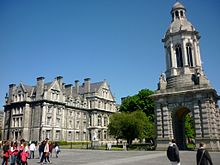
Dublin is home to several universities and various other academic and cultural institutions. The most important are:
- University of Dublin, better known as Trinity College Dublin (TCD)
- University College Dublin (UCD)
- Dublin City University (DCU)
- Technological University Dublin (TU Dublin) (with Dublin Institute of Technology (DIT), Institute of Technology, Tallaght (ITT Dublin), Institute of Technology, Blanchardstown (ITB))
- National College of Art and Design (NCAD)
- Dublin Institute for Advanced Studies (DIAS)
- Royal College of Surgeons in Ireland (RCSI)
- Griffith College Dublin (GCD)
- Dublin Business School (DBS)
- National College of Ireland (NCI)
Culture and sights

The district Temple Bar is Dublin's cultural quarter (especially for tourists ) with a lively nightlife. It is located on the south bank of the River Liffey in central Dublin. In contrast to the surrounding districts, Temple Bar has preserved its medieval streets with many narrow cobblestone streets. Temple Bar is known for its pubs and nightlife with live music.
A new landmark of the city is the Spire built in 2003 by British architect Ian Ritchie next to the main post office on O'Connell Street , a 123 meter high stainless steel column that extends from a diameter of 3 meters at the base to 15 centimeters in the tapered tip illuminated at night. The Dubliners jokingly refer to the Spire as "the world's largest toothpick".
In a ranking of cities according to their quality of life, Dublin ranked 34th out of 231 cities worldwide in 2018.
Buildings worth seeing
- Georgian Architecture / Georgian Dublin
- Trinity College Dublin
- Ha'penny Bridge (1819)
- Sean O'Casey Bridge (2005)
- Samuel Beckett Bridge (2009) designed by Spanish architect Santiago Calatrava .
- James Joyce Bridge (2003)
- Custom House (1781/91)
- City Hall: Dublin City Hall (1769/79), Dame Street
- The Spire , O'Connell Street
- Leinster House : now the seat of the Irish Parliament
- Government Buildings : a magnificent domed structure and home to the Prime Minister's and Treasury departments.
- Irish National Library , Kildare Street
- Dublin Castle , Cork Hill
- Four Courts : the main courthouse in Ireland
- Irish Parliament House : Today there is a branch of the Bank of Ireland , College Green.
- Dublin City Library and Archive
Monuments

- Molly Malone
- The statue of Daniel O'Connell - the driving force in Ireland's politics from the late 1820s to his death in 1847. Today the street is named after it. Built from 1864 to 1883 by John Foley
- The statue of James Larkin - the leader of the 1913 Dublin general strike
- The statue of Father Theobald Mathew (1790–1856) - a pioneer of the movement for alcohol abstinence
- The statue of Charles Stewart Parnell , a late 19th century political leader in Ireland
-
Monuments to the victims of the Great Famine (Famine) :
- by Edward Delaney RHA at St. Stephen's Green in Dublin
- by Rowan Gillespie across from the International Financial Services Center
- The statue of the Irish-Argentine admiral William Brown , "father" of the Argentine Navy.
- The statue of the Irish singer / musician and front man of the band Thin Lizzy Phil Lynott
Churches
Although most of the Irish are Catholics (84.2%), the two most famous Dublin churches belong to the Anglican Church of Ireland .
Another well-known church in the Church of Ireland is St. Michan's Church , best known for its mummies.
Catholics have only one pro-cathedral , St Mary's Pro-Cathedral . Another larger Catholic church is John's Lane Church . The striking neo-Gothic St Stephen's Green Church on St. Stephen's Green Park belongs to a Unitarian congregation.
graveyards
- Glasnevin Cemetery , in Glasnevin, a northern borough, is the largest cemetery in Ireland .
- Mount Jerome Cemetery is located in Harold's Cross, a southern district.

music
Irish folk music is very successful in Dublin (as in the rest of Ireland ). Folklore groups play more or less regularly in many pubs. Modern music is even more popular, especially among the younger population.
theatre
Museums and exhibitions
- National Museum
- National Gallery of Ireland
- Irish Museum of Modern Art
- Hugh Lane Gallery
- Kilmainham Gaol : the old prison recalls the history of Irish independence
- Book of Kells in the Trinity College Library
- National Wax Museum : wax museum
- Number 29 : A house exemplified by the Dublin energy works showing life around 200 years ago
- Guinness Storehouse
- The Old Jameson Distillery
- Dublinia
- Chester Beatty Library
- Dublin Writers Museum
- Irish Whiskey Museum
- Little Museum of Dublin
Parks and green spaces
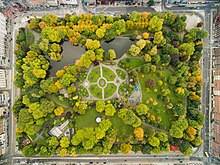
- National Botanic Gardens (Botanic Garden)
- St. Stephen's Green ; the adjacent Grafton Street is the city's most famous shopping street
- Archbishop Ryan Park
- Iveagh Gardens
- Blessington Street Basin
- Phoenix Park is the largest park in the city and is home to many wild animals. Phoenix Park is home to the Irish President and the American Ambassador.
- Dublin Zoo is located in Phoenix Park and is the largest zoo in Ireland
- Walks along the Grand Canal and the Royal Canal
Dublin in literature
Dublin is the literary setting of the classic novel Ulysses , in which James Joyce depicts Leopold Bloom's wanderings through the city in a single day and draws a portrait of the city in the process. In honor of the novel, Bloomsday is celebrated annually on June 16 . Joyce's short stories from the Dubliner Collection also take place in the Irish capital, as does the framework for the postmodern novel Two Birds Swim by Flann O'Brien .
Vicinity of Dublin
- Bray : Beach town south of Dublin
- The passage tomb by Fourknocks
- Glendalough Monastery Ruins : Saint Kevin founded this monastery in the 6th century. He is the city patron of Dublin.
- Hill of Slane : Saint Patrick lit the first Easter bonfire in Ireland there in 433
- Hill of Tara : prehistoric monuments and tombs
- Irish National Stud : the Irish national stud with attached Japanese gardens
- Killiney Hill : the hill and southern boundary of Dublin Bay with views over Dublin to the northwest, Wales to the east and Bray to the southeast. There is an obelisk at the top of the hill.
- Malahide seaside resort and castle : north of Dublin
- Mellifont Abbey : Monastery ruins from 1142
- Monasterboice : Round tower and three sandstone high crosses from the 9th century
- Barrows of Newgrange and Knowth
- Portmarnock : beach and golf course
- Powerscourt Gardens : Georgian mansion with remarkable gardens, including the Powerscourt Waterfall , the largest waterfall in Ireland, south of Dublin
- Russborough House : 18th century mansion in County Wicklow with a historic interior and modern exhibition
- Howth fishing village and peninsula
- Wicklow Mountains : the mountainous garden of Ireland, south of Dublin
- Williamstown Castle
Sports
Almost all Irish sports organizations are headquartered in Dublin. The 82,500-seat Croke Park in Drumcondra is home to the Gaelic Athletic Association (GAA). Gaelic football and hurling games take place there in the summer months .
The stadium on Lansdowne Road held 49,250 spectators and is owned by the Irish Rugby Football Union . In addition to rugby games for the Leinster Rugby team , the home games for the Irish national football team also took place there. This stadium was replaced by the Aviva Stadium in 2010 . Dalymount Park in the Phibsboro district was the traditional home ground of Irish football. Today the Bohemians Dublin football club plays there . Their rival, Shelbourne FC , plays in nearby Tolka Park, while St Patrick's Athletic is based in Richmond Park in Inchicore on the south-west edge of downtown. The Shamrock Rovers are originally from Milltown, but now after two decades they are looking for a new home in the Tallaght district.
The National Swimming Center is located in the Blanchardstown district . There are several racetracks spread across the city. Greyhound races are held at Shelbourne Park , and Leopardstown is a horse racing track that hosted the 2002 World Cross Country Championships . The Dublin Horse Show in the RDS Arena in Ballsbridge is world famous . The world show jumping championships took place there in 1982. There are also major sports facilities for basketball, handball and hockey in Dublin. The most important athletics stadium is the Morton Stadium in Santry.
The Dublin Marathon , one of the largest marathons in Europe, took place annually on Autumn Bank Holiday, the last Monday in October, until 2016, and on the last Sunday in October since 2017. Ireland's second major running event, the 10km Great Ireland Run , also takes place in Dublin.
Personalities
See also
literature
- Richard Killeen: A Short History of Dublin . Gill & Macmillan, Dublin 2010, ISBN 978-0-7171-4417-4 .
- Pat Liddy: Dublin. A celebration. From the 1st to the 21st century . Dublin City Council, Dublin 2000, ISBN 0-946841-50-0 .
- Hans-Christian Oeser : Dublin. A travel companion . Insel, Frankfurt am Main 2005, ISBN 3-458-34814-X . (literary walks)
- Andreas P. Pittler (Ed.): Dublin . Wieser, Klagenfurt 1998, ISBN 3-85129-261-8 . (Anthology in the Europa select series )
- Ralf Sotscheck : Dublin. A city in biographies . Travel-House-Media, Munich 2013, ISBN 978-3-8342-1363-1 .
- PF Wallace, HB Clarke: Dublin . In: Lexicon of the Middle Ages (LexMA). Volume 3, Artemis & Winkler, Munich / Zurich 1986, ISBN 3-7608-8903-4 , Sp. 1426-1433.
Web links
- Official site of the City Council (English)
- Statistical data from the Central Statistic Office on Ireland and Dublin (English)
- Illustration of the city in 1611 in Civitates orbis terrarum by Georg Braun and Frans Hogenberg
- Statistical data of the city administration of Dublin (English)
Individual evidence
- ↑ http://www.logainm.ie/Eolas/Data/Brainse/baile-atha-cliath-dublin.pdf Baile Átha Cliath - Dublin
- ^ Denis McCarthy: Dublin Castle. At the heart of Irish History . Stationary Office, Dublin 2004, ISBN 0-7557-1975-1 , pp. 12-16.
- ↑ Éamonn Mac Thomáis: Me Jewel and Darlin 'Dublin . The O'Brien Press, Dublin 2004, ISBN 0-905140-27-3 , pp. 52, 12-16.
- ^ Denis McCarthy: Dublin Castle. At the heart of Irish History . Stationary Office, Dublin 2004, ISBN 0-7557-1975-1 , p. 16.
- ↑ Census 2011 - Town and Country: Table 3 , (PDF; 6.6 MB)
- ↑ Councilors , accessed August 7, 2020
- ↑ Green Party's Hazel Chu is new Lord Mayor of Dublin , June 29, 2020, RTE
- ↑ IFCS website , accessed on May 21, 2016
- ↑ Dublin City Council ( Memento of the original from April 10, 2014 in the Internet Archive ) Info: The archive link was inserted automatically and has not yet been checked. Please check the original and archive link according to the instructions and then remove this notice.
- ↑ Twitter to set up international HQ in Dublin
- ↑ Study: Comparison of HQ business environments: Headquarters locations in Europe 2011 rankings ( Memento of the original from September 7, 2011 in the Internet Archive ) Info: The archive link was inserted automatically and has not yet been checked. Please check the original and archive link according to the instructions and then remove this notice.
- ↑ Global Destination Cities Report 2016. (PDF) (No longer available online.) Mastercard, archived from the original on September 24, 2016 ; accessed on July 11, 2018 . Info: The archive link was inserted automatically and has not yet been checked. Please check the original and archive link according to the instructions and then remove this notice.
- ↑ Mercer's 2018 Quality of Living Rankings. Retrieved July 30, 2018 .
- ↑ Information from Dublin City Council on the Samuel Beckett Bridge ( Memento of the original from August 8, 2011 in the Internet Archive ) Info: The archive link was automatically inserted and not yet checked. Please check the original and archive link according to the instructions and then remove this notice.
- ↑ census2011 (PDF; 7.6 MB)
- ^ Website of the Irish Whiskey Museum . Retrieved January 27, 2015.
- ↑ https://www.littlemuseum.ie
